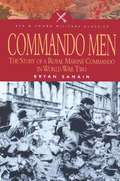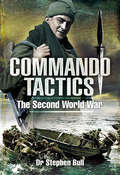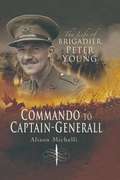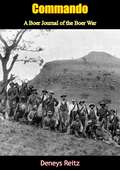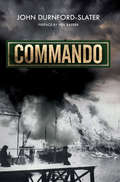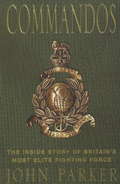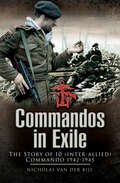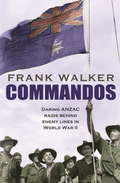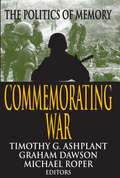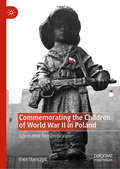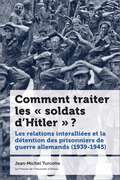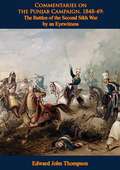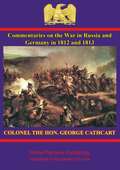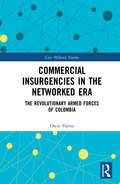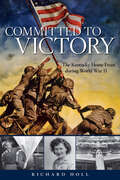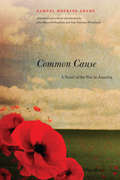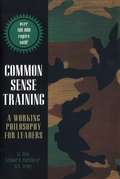- Table View
- List View
Commando Men: The Story of A Royal Marine Commando in World War Two (Pen & Sword Military Classics)
by Bryan SamainFirst published in 1948 as Commando Men- The Story Of A Royal Marine Commando in North-West Europe, the book tells the story of the men of General Section 45 Royal Marine Commando in N.W. Europe. Samain was the Intelligence Officer of No. 45 Royal Marine Commando, and in this revised edition the book gives a complete yet concise account of their operations from D-Day until VE-Day, through Northern France to the Baltic.
Commando Tactics: The Second World War
by Dr. Stephen BullBritish commandos are among the most celebrated soldiers of the Second World War. Their daring, ingenuity and bravery have given rise to an almost legendary reputation that makes it difficult to appreciate fully their role and their true value as fighting men.Stephen Bull, in this in-depth study of commando tactics and history, seeks to dispel the myths and the misunderstandings that surround them, and he places these elite troops of 70 years ago in the context of their times. He also demonstrates that the idea of the commando took time to develop and that commando operations were far from always successful. Commando tactics amphibious, mountain, close quarter were forged through the often-painful experience of raids and combined operations. And commando tactics and organization remained in a state of flux throughout the war as new situations and challenges arose.Stephen Bulls vivid account will be essential reading for anyone who is interested in commando fighting techniques and the early history of special forces.
Commando to Captain-Generall: The Life of Brigadier Peter Young
by Alison MichelliThis is the story of Brigadier Peter Young (1915–1988), a highly decorated soldier who was one of the founding members of 3 Commando, rising during WWII from 2 Lt to Brigadier in the space of 6 years. His battle honours include Vaagso, Dieppe, Sicily, Italy, Normandy and Burma. A career soldier, he returned to his parent regiment, the Beds and Herts, after the war and subsequently spent time in Palestine where he commanded the 9th Regiment of the Arab Legion under Glubb Pasha. After Suez he returned to England, retiring from the Army in 1959. He founded the War Studies Department at RMA Sandhurst during the 60s, intending to create there a intellectual centre along the lines of a university faculty for the study of military history and to that end gathered around him some of the finest military historians of the day including Richard Holmes, David Chandler and John Adair amongst others. He was instrumental in the forming of The Sealed Knot and is reverred in re-enactment circles. To publicise a book he had written about the English Civil War he organised a publicity stunt which evolved rapidly into the first re-enactment society: The Sealed Knot. An avid war-gamer, his name is legendary in war-gaming circles. 'The Brig' is still a well-known personality even among those too young ever to have met him.
Commando: A Boer Journal of the Boer War [Illustrated Edition]
by Deneys Reitz F.-M. J. C. SmutsDuring his exile in Madagascar, Boer soldier Deneys Reitz wrote about his experience of the Second Boer War (1899-1902). When it was eventually edited and published in 1929 as Commando: A Boer Journal of the Boer War, it still had the freshness and detail of an account written soon after the war.Reitz’ descriptions of the tumult through the eyes of a warrior in the saddle form not only a succinct narrative and important source for the Second Boer War, but his family connections (his father Francis William Reitz was State Secretary of the Transvaal), sheer luck, and participation at virtually every major event of the War all provide for a unique account.A vivid, unforgettable picture of mobile guerrilla warfare.Richly illustrated throughout.
Commando: Memoirs of a Fighting Commando In World War Two
by John Durnford-SlaterExciting World War II action The exploits of Britain's wartime commandos Covers fighting in Norway, Italy, France and Germany John Durnford-Slater raised and trained the first Commando unit in 1940, became an outstanding leader of special operations and witnessed some of the most daring exploits of World War II. Commando is his remarkable story. 3 Commando sprang into being in 1940 in order to harry Axis forces in pinprick raids that were impossible for regular army units. In the summer of 1940 John Durnford-Slater led the men of 3 Commando in an exploratory operation on Guernsey. A raid on the Loften Islands, off Norway, followed in 1941 and, between 26 and 28 December 1941, the commandos launched their raid against Vaagso. 3 Commando took part in the raid on Dieppe and this was followed by operations in Sicily and Italy, France and, ultimately, Germany itself. The destruction wrought by the commandos was such that Hitler ordered all personnel captured in such raids executed. The commandos' spirit, however, remained undaunted and this is reflected in John Durnford-Slater's exciting and forthright memoirs. Now placed in context by David List's details of 3 Commando's operations, and David Buxton's notes on casualties and awards, this stirring book, long heralded as a classic, now makes its first appearance as a paperback. John Durnford-Slater was appointed 'to raise and command' 3 Commando in 1940. He was later responsible as Deputy Commander of the Special Service Group for all Commando companies taking part in the invasion of France.
Commando: Memoirs of a Fighting Commando In World War Two
by John Durnford-SlaterExciting World War II action The exploits of Britain's wartime commandos Covers fighting in Norway, Italy, France and Germany John Durnford-Slater raised and trained the first Commando unit in 1940, became an outstanding leader of special operations and witnessed some of the most daring exploits of World War II. Commando is his remarkable story. 3 Commando sprang into being in 1940 in order to harry Axis forces in pinprick raids that were impossible for regular army units. In the summer of 1940 John Durnford-Slater led the men of 3 Commando in an exploratory operation on Guernsey. A raid on the Loften Islands, off Norway, followed in 1941 and, between 26 and 28 December 1941, the commandos launched their raid against Vaagso. 3 Commando took part in the raid on Dieppe and this was followed by operations in Sicily and Italy, France and, ultimately, Germany itself. The destruction wrought by the commandos was such that Hitler ordered all personnel captured in such raids executed. The commandos' spirit, however, remained undaunted and this is reflected in John Durnford-Slater's exciting and forthright memoirs. Now placed in context by David List's details of 3 Commando's operations, and David Buxton's notes on casualties and awards, this stirring book, long heralded as a classic, now makes its first appearance as a paperback. John Durnford-Slater was appointed 'to raise and command' 3 Commando in 1940. He was later responsible as Deputy Commander of the Special Service Group for all Commando companies taking part in the invasion of France.
Commandos
by Douglas WallerA precursor to American Sniper or Seal Team Six, The Commandos is a heart-pounding look at what it takes to fight alongside the very best of America's armed forces.In The Commandos, veteran Pentagon correspondent for Newsweek Douglas Waller gives a behind-the-scenes look at the most secret and elite of clandestine warriors. Offering inside details of the U.S. special operations forces, including Green Berets, Navy SEALs, and Delta Force, Waller reveals the excruciating training and dangerous missions of America's elite fighting forces as he follows them following them into battle in Operation Desert Storm.
Commandos
by John ParkerThe Commandos were Britain's first-ever special forces, formed in 1940 using volunteers from all three services. After the war, Commando units of the Royal Marines engaged in virtually every military scenario involving British troops from 1945 to the present day. They became the elite of the British 'ready-to-go' forces, capable of deploying at a moment's notice to any trouble spot in the world. In this latest book in John Parker's acclaimed series on British military activity, dramatically recalled in their own words by men who were there, he recounts the major events in the 60-year history of British Commando forces.
Commandos
by John ParkerThe Commandos were Britain's first-ever special forces, formed in 1940 using volunteers from all three services. After the war, Commando units of the Royal Marines engaged in virtually every military scenario involving British troops from 1945 to the present day. They became the elite of the British 'ready-to-go' forces, capable of deploying at a moment's notice to any trouble spot in the world. In this latest book in John Parker's acclaimed series on British military activity, dramatically recalled in their own words by men who were there, he recounts the major events in the 60-year history of British Commando forces.
Commandos & Rangers: D-Day Operations
by Tim Saunders&“A first-class work detailing the work of the elite British Commandos and their American counterpart the Rangers . . . Outstanding . . . 10/10.&” —The Great War Magazine In the dark days of 1940, Prime Minister Winston Churchill showed his belief in ultimate victory by ordering the raising of the elite Commandos to &“break the intolerable shackles of defeat.&” Having proved their worth in numerous raids and operations in the Mediterranean, they and their American counterparts, the Rangers, were automatic choices for the most demanding and vital missions of the D-Day Landings in June 1944. These included the capture of key ports, enemy coastal defences and the securing of vulnerable open flanks. The tasks allotted to the Rangers included the seizure of Pointe du Hoc while No 4 Commando took the port of Ouisterham and 47 Royal Marine Commando that of Port-en-Bessin. These daring actions and many others are vividly described in this superb book written by a highly experienced battlefield tour expert and the author of many acclaimed guide books. Indeed, each chapter concludes with invaluable tour notes for those who wish to visit these historic sites. It was only thanks to thorough planning, specialist training, inspiring leadership and, above all, the courage of the men involved that these missions were successfully achieved—but at great cost.
Commandos in Exile: The Story of 10 (Inter-Allied) Commando, 1942–1945
by Nicholas van der BijlFormed from members of Free Forces who had escaped from German occupation, 10 (Inter-Allied) Commando was one of the most unusual units in WW2. All members had to pass the Green Beret commando course at Achnacarry in Scotland and the book begins by describing this training. With no less than six national troops, plus X Troop drawn from exiled Jews, 10 Commando never fought as an entity but loaned troops for specific operations, such as One Troop (French) taking part in the Dieppe Raid, 2 Troop (Dutch) fighting at Arnhem, 5 Troop (Norwegian) raiding the Lofoten Islands etc. At other times groups played a key intelligence role questioning POWs, translating captured documents, conducting reconnaissance patrols and intelligence gathering on the D-Day beaches. The history of X Commando, made up of escaped Jewish individuals is especially interesting.The book also reviews the growth of post-war national Commando forces.
Commandos: Heroic and Deadly ANZAC Raids in World War II
by Frank WalkerAmazing revelations and extraordinary exploits of Australia's elite secret warriors.There was something unique about Australians and New Zealanders in war that prompted World War II Allied commanders to turn to ANZAC soldiers, sailors and airmen to carry out the most dangerous and virtually impossible missions behind enemy lines.Paddling canoes 4,000 kilometres to attack enemy ships in Singapore; lightning raids on Rommel's forces in the deserts of North Africa. Flying bombers at tree-top level deep into Nazi Germany to destroy vital targets; rescuing sultans and future US presidents from under the noses of the Japanese and playing crucial roles in the greatest commando raid of the war at St Nazaire - the Aussies and Kiwis were there.The special forces showed incredible bravery in the face of overwhelming odds. They were determined to complete their missions. Often alone and far behind enemy lines,they demonstrated resourcefulness, spirit and a humanity that inspired others to follow them.Frank Walker, author of bestselling books on the Vietnam War and the British atomic tests in Australia, brings to life the amazing exploits and extraordinary stories of this select band of heroes..
Commandos: The CIA and Nicaragua’s Contra Rebels
by Sam Dillon"Commandos" is a narrative based largely on the personal experiences of Luis Fley who had at the peak of Nicaragua's contra war, led a rebel battalion, commanding hundreds of fighters in combat ranging over three provinces. But by 1988, when Dillon met him, he'd taken a U.S.-financed rearguard post that put him in charge of investigating crimes committed by contra fighters. A contra detective? What a fascinating idea.
Commemorating War: The Politics of Memory
by Graham Dawson Timothy G. Ash PlantWar memory and commemoration have had increasingly high profiles in public and academic debates in recent years. This volume examines some of the social changes that have led to this development, among them the passing of the two world wars from survivor into cultural memory. Focusing on the politics of war memory and commemoration, the book illuminates the struggle to install particular memories at the center of a cultural world, and offers an extensive argument about how the politics of commemoration practices should be understood.Commemorating War analyzes a range of forms of remembrance, from public commemorations orchestrated by nation-states to personal testimonies of war survivors; and from cultural memories of war represented in films, plays and novels to investigations of wartime atrocities in courts of human rights. It presents a wide range of international case studies, encompassing lesser-known national histories and wars beyond the well-trodden terrain of Vietnam and the two world wars in Europe.Emerging from this book is an important critique of both "state-centered" approaches to war memory and those that regard commemoration primarily as a human response to loss and grief. Offering a wealth of empirical research material, this book will be important for cultural and oral historians, sociologists, researchers in international relations and human rights, and anybody with an interest in the cultural construction of memory in contemporary society.
Commemorating the Children of World War II in Poland: Combative Remembrance
by Ewa StańczykThis book explores contemporary debates surrounding Poland’s 'war children', that is the young victims, participants and survivors of the Second World War. It focuses on the period after 2001, which saw the emergence of the two main political parties that were to dictate the tone of the politics of memory for more than a decade. The book shows that 2001 marked a caesura in Poland’s post-Communist history, as this was when the past took center stage in Polish political life. It argues that during this period a distinct culture of commemoration emerged in Poland – one that was not only governed by what the electorate wanted to hear and see, but also fueled by emotions.
Comment traiter les « soldats d’Hitler » ?: Les relations interalliées et la détention des prisonniers de guerre allemands (1939-1945) (Études canadiennes)
by Jean-Michel TurcotteFar from being restricted to barbed wire camps or within the borders of a single nation, the detention of German soldiers remains a little-known part of history in the specific context of the triangular relationships between Ottawa, Washington, D.C., and London.It is from this perspective that the book Comment traiter les « soldats d’Hitler ? » (How to Treat “Hitler’s Soldiers”?) explores the political dynamics between Canadian, American, and British authorities regarding the treatment of German prisoners of war. Throughout the Second World War, these Allied forces detained close to 600,000 of “Hitler’s soldiers” on their respective territories. While managed by each state, these incarceration operations raise several issues involving interallied cooperation.This detailed analysis compares the captivity regimes developed by each government according to their national prerogatives and looks at important differences in how the three North Atlantic Allies dealt with enemy soldiers. Turcotte takes stock of the countries’ common and respective policies, which stemmed from participation in joint projects, regular meetings looking to better coordinate their actions, consultations and correspondence between them, as well as discussions on problems tied to the detention of prisoners of war and the solutions put forth. It also presents each state’s position on the 1929 Geneva Convention, the forced labour of detainees, and the denazification program. The conditions of captivity for German soldiers were therefore the result of mutual influence between the three main detaining powers of the Western Front, which was shaped by each of their experience. Following this argument, the author brings to light the key role Canada played within the Allied forces at the time. Published in French.
Commentaries on the Punjab Campaign, 1848-49: the Battles of the Second Sikh War by an Eyewitness
by James Henry Lawrence-Archer“An infantry officer's view of the fall of the Sikhs.The author of this book served with No 6 company of HM 24th Regiment-an infantry regiment of the British Army-which saw much service in the Second Sikh War and suffered greatly in the fighting particularly at Chillianwalla. So there could hardly be a more qualified writer—or one with closer connections to other participants—to take on the task of reporting the war. At the conclusion of the First Sikh War there remained a sense of business unfinished. The Sikhs were yet masters of the Punjab and the Khalsa remained one of the most formidable armies the Sub-Continent had ever seen. Most importantly the centre of Sikh power, the seemingly impregnable and daunting fortress of Mooltan remained defiant. Once again the British Empire learnt the lesson of what a formidable foe the Sikhs were as they joined battle with them at Ramnuggar, Chillianwalla, Mooltan and Googerat. Archer takes us through this campaign in compelling detail embellished by an insight only first hand experience can provide.”-Print ed.
Commentaries on the war in Russia and Germany in 1812 and 1813
by Colonel Sir George CathcartColonel Cathcart, as he was then, was assigned to the court of Russia just before Napoleon launched his massive assault in 1812. He attached himself to the Emperor Alexander's suite and followed the war closely as the French struggled toward Moscow and, as the remnants, suffered upon marching back in the shattering cold of the winter. Colonel Cathcart saw and recorded in this book what few believed possible - Napoleon thoroughly defeated by his own hubris and hundreds of miles of snow covered desert. He marched on toward the climactic battles for the possession of Germany in 1813, with Napoleon restricted to the boundaries of France following the bloody battle of Leipzig.Colonel Cathcart recorded all he saw at head-quarters and beyond in the field and wrote his history of the campaigns shortly before his death in 1854 in the Crimean War. Accompanying his well-written text are numerous maps of the engagements and theatres.Author -- General Sir George Cathcart (1794-1854)Text taken, whole and complete, from the edition published in London, J. Murray, 1850.Original Page Count - xv and 383 pages.Illustrations -- 15 maps and plans
Commentary on the First Geneva Convention: Convention (I) for the Amelioration of the Condition of the Wounded and Sick in Armed Forces in the Field (Commentaries on the 1949 Geneva Conventions)
by Michael Meyer Lindsey Cameron Knut Dörmann Bruno Demeyere Iris Müller Jean-Marie Henckaerts Heike Niebergall-Lackner Tristan Ferraro Eve La Haye Cordula Droege Robin Geiss Laurent Gisel François Bugnion Sylvain Vité Helen Durham Sandesh Sivakumaran Alexander Breitegger Jann K. Kleffner Geoffrey S. Corn Dana Constantin Stephan Michel Claude SchenkerThe application and interpretation of the four Geneva Conventions of 1949 and their two Additional Protocols of 1977 have developed significantly in the sixty years since the International Committee of the Red Cross (ICRC) first published its Commentaries on these important humanitarian treaties. To promote a better understanding of, and respect for, this body of law, the ICRC commissioned a comprehensive update of its original Commentaries. Its preparation was coordinated by Jean-Marie Henckaerts, ICRC legal adviser and head of the project to update the Commentaries. The First Convention is a foundational text of international humanitarian law. It contains the essential rules on the protection of the wounded and sick, those assigned to their care, and the red cross and red crescent emblems. This article-by-article Commentary takes into account developments in the law and practice to provide up-to-date interpretations of the Convention. The new Commentary has been reviewed by humanitarian-law practitioners and academics from around the world. It is an essential tool for anyone working or studying within this field. An article-by-article Commentary on the First Geneva Convention and Additional Protocols issued by the International Committee of the Red Cross, capturing contemporary developments in their application and interpretation. Contains thorough and up-to-date interpretations from an extensive process involving both International Committee of the Red Cross and external contributors, as well as peer review by academics and international humanitarian law practitioners, ensuring coherent content while accurately reflecting diverging views. Provides practitioners and scholars with easy access to comprehensive, high-quality legal information.
Commercial Insurgencies in the Networked Era: The Revolutionary Armed Forces of Colombia (Cass Military Studies)
by Oscar PalmaThis book examines the Revolutionary Armed Forces of Colombia (FARC) as a commercial insurgency through the network-complex paradigm of insurgency. Countering traditional perspectives of the group, it proposes new and comprehensive explanations for the FARC’s presence in Latin America. Existing narratives have portrayed the FARC as a terrorist, narco-terrorist, or criminal organization – a narrative popularized by the government offensive conducted by the Colombian state during the last couple of decades. In contrast, this book goes beyond simplistic perspectives of the FARC and instead studies the group in relation to the network-complex paradigm of insurgency. It explains the organization as a ‘commercial insurgency’ with three dimensions – political, criminal, and military – and understands the Colombian insurgency not as a monolith, but as a system of individuals with diversified interests ranging from the highly indoctrinated to the profit-motivated. This examination allows for an analysis of some of the insurgency’s most unexplored characteristics: an interest in urbanizing its actions and the increased ‘invisibility’ of combatants, the significance of its political institutions, and the construction of its transnational networks. The volume also discusses the future of FARC in post-conflict Colombia, not only within the country but as an actor in the region. This work will be of much interest to students of insurgencies, military studies, Latin American studies, criminology, security studies, and IR.
Committed to Victory: The Kentucky Home Front during World War II (Topics In Kentucky History Ser.)
by Richard Holl“Deeply researched and clearly written . . . a wide-ranging and detailed account of Kentucky’s society, economy, and politics during World War II.” —John W. Jeffries, author of Wartime AmericaWhen World War II broke out in Europe in September 1939, Kentucky was still plagued by the Great Depression. Even though the inevitably of war had become increasingly apparent earlier that year, the citizens of the Commonwealth continued to view foreign affairs as a lesser concern compared to issues such as the lingering economic depression, the approaching planting season, and the upcoming gubernatorial race. It was only the Japanese attack on Pearl Harbor that destroyed any lingering illusions of peace.In Committed to Victory: The Kentucky Home Front During World War II, author Richard Holl offers the first comprehensive examination of the Commonwealth’s civilian sector during this pivotal era in the state’s history. National mobilization efforts rapidly created centers of war production and activity in Louisville, Paducah, and Richmond, producing new economic prosperity in the struggling region. The war effort also spurred significant societal changes, including the emergence of female and minority workforces in the state. In the Bluegrass, this trend found its face in Pulaski County native Rose Will Monroe, who was discovered as she assembled B-24 and B-29 bombers and was cast as Rosie the Riveter in films supporting the war effort.Revealing the struggles and triumphs of civilians during World War II, Holl illuminates the personal costs of the war, the black market for rationed foods and products, and even the inspiration that coach Adolph Rupp and the University of Kentucky basketball team offered to a struggling state.
Commodore Hornblower (The Hornblower Saga, Book #4)
by C. S. ForesterNow Captain Hornblower has been promoted to Commodore and is in command of a squadron of ships in the Baltic in 1812. He is now confronting Bonaparte in Russia and assisting at the siege of Riga.
Common Cause: A Novel of the War in America
by Samuel Hopkins AdamsA lost literary relic of the First World War, Common Cause tells the story of Jeremy Robson, a crusading newspaper editor in the fictional midwestern town of Fenchester. The Guardian’s muckraking has led special interests to withhold advertising in order to drive Robson out of business. But he and local plutocrats put their differences aside when war is declared in 1917 in order to attack the German-American community for its supposed fealty to their Fatherland. Common Cause provides a vivid picture of the America-first fear and hate that gripped the midwestern United States during the Great War.
Common Sense Training: A Working Philosophy for Leaders
by Arthur Collins"The best book on military training from platoon to division level that has been published in any army."--Army Magazine
Commonalities In Russian Military Operations In Urban Environments
by Major Dale R. SmithDespite the drastic evolution of warfare since the close of World War II fighting in urban environments has remained a constant. Despite the advances in modern warfare the tactics, techniques and procedures developed for urban combat operations remain largely unchanged. As the sole remaining superpower, The United States will likely find itself increasingly drawn into urban operations to perform stability and peacekeeping operations. In doing so it advantage in technology will be significantly reduced. By conducting a study of the Russian operations in Chechnya and comparing it to operations in Stalingrad some enduring traits began to emerge. These traits are significant for the unit wanting to understand how urban operations manifest unforeseen problems. More importantly, as many third world countries have been trained or have studied under Russian doctrine they may exhibit similar methodologies. The analysis contains more than a historical and tactical account of the actions. It attempts to identify the underlying themes that drive the history.
